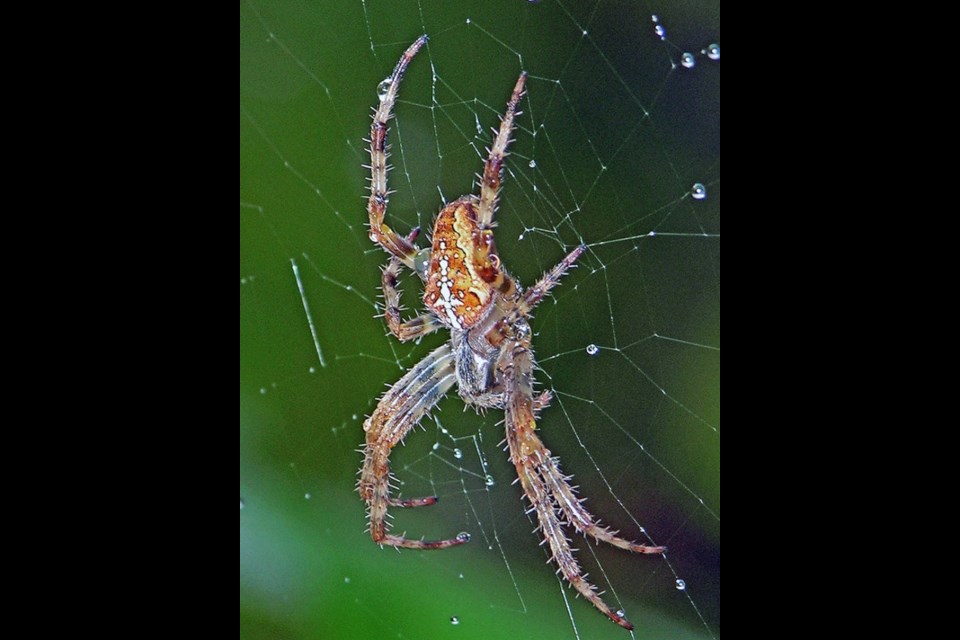There’s a saying among arachnologists that you’re never more than five feet from a spider.
That’s especially true in British Columbia, where there are nearly 900 documented species of spiders — and likely many more that haven’t even been discovered yet.
This time of year, you’re likely to find some walking across your living room or in your bathtub. They might have slipped in through the crack under your door, or hitched a ride when you walked through a web in the garden.
But don’t worry, say local arachnologists. They are quite harmless and only there by accident.
It’s mating season in the spider world and males are wandering around looking for females, says Claudia Copley, collection manager and researcher in the entomology department of the Royal B.C. Museum.
“Males leave the web and go smelling for females,” she says. “He might follow the wall of the house and end up at a doorway or window, and they come in, not following a smell but by accident.
“They are looking for love in all the wrong places because they are often killed.”
Copley said the most common eight-leggers you’ll find are the garden cross orbweaver spider (Araneus diadematus) and the giant house spider (Eratigena atrica), which are commonly but incorrectly referred to as wolf spiders. Another is the hobo spider (Eratigena agrestis).
All are introduced species and harmless to people.
Their lifespans are only a year. When the mating is done, the female lays her eggs in silken pods and hides them away for spring hatching. She dies, and sometimes eats the male before she goes.
Arachnologist Rick West said while some spiders will bite, the only one British Columbians have to worry about is the Western black widow (Latrodectus hesperus), which has a pea-sized, polished black abdomen with hourglass-shaped red marking.
Its bite and small dose of venom can cause abdominal cramps and swelling, but nothing more, said West.
West said the Western black widow rarely leaves its hiding place and lives for two or three years. It’s common from Sooke to Victoria and up the inside coast to Comox. It likes mossy outcroppings in gardens and rocky slopes such as Mount Douglas and Mount Tolmie.
The brown recluse spider is not found in British Columbia — nor north of Nevada, said West, but there are stories every year of people saying they’ve seen one or killed one.
He said it stems from a story a few years ago of a young girl from B.C. who had been camping in Baja, California, with her family and brought one back in her sleeping bag. The family went camping when they returned and the girl was bitten, and had to have a portion of her thigh cut out.
“It was a fluke, but people don’t forget. They see a big brown spider and the story stuck.”
West said people often blame spiders for bites when the culprits are actually bed bugs, lice, fleas, ticks and other insects.
Perhaps the most creepy of spiders in these parts is a native species — the Pacific folding-door spider (Antrodiaetus pacificus), a distant relative of tarantulas that can live up to 20 years.
A specimen was flushed out of its silky burrow in the ground in May in Langford, likely from heavy rain.
Copley said folding-door spiders lay trap webs outside their holes and wait for prey to be caught, then pull it in for dinner. The females never leave their burrows and the males wander the forests.
Research teams at the Royal B.C. Museum expect to continue discovering new species of spiders, said Copley.
She said the pandemic put a halt to field research this year, but it will eventually continue. There are many areas that haven’t yet been reached, including high alpine areas or B.C.’s extensive cave systems.
Up to the late 1960s, 260 species of spiders had been identified in B.C. Today, the number is 893 — a huge number for the province, given that there are 1,600 documented species in Canada overall.
Copley credits the diversity of habitats — mountain ranges, valleys, prairie, deserts and coastal forests — for spiders’ ability to flourish here.
Some species are also introduced here via planes and ships, and are discovered around Â鶹´«Ã½Ó³»International Airport and Lower Mainland ports.
The 893 species might make those fearful of spiders shiver, but Copley says more than half of those are less than half a centimetre in size at full maturity. And most are hardly ever seen.
But make no mistake. Spiders are useful to humans.
“I can give you the old quote: ‘We’d be up to our asses in flies without spiders,’ ” said West. “They take care of a lot of insects that carry diseases for humans and cause crop damage.”
West said it’s been “hard-wired into us that spiders can injure you and should be killed on sight.
“And a lot of people still have that knee-jerk reaction. We should just let them live and go about their business.”
Read more from the



